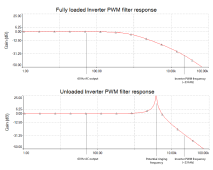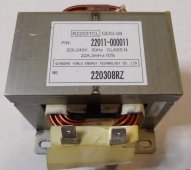All modern inverters using PWM digital sinewave creation have an output L-C filter to smooth out the PWM chopping to a pure sinewave.
The L-C filter has a typical cutoff corner frequency between 2 kHz to 4 kHz. When inverter is lightly loaded the L-C filter becomes very undamped which makes it vulnerable to ringing near the filter's cutoff frequency. Impulse current loads like simple rectifier-filter power supplies that draw short bursts of current at the peak voltage of AC sinewave, can set the L-C filter ringing. This is AC loads with high current crest factors and poor power factors.
The L-C filter ringing can upset the inverter's AC voltage feedback regulation causing it to become unstable on holding its AC output voltage regulation. Result of the unstable AC voltage regulation is the flickering of lights as the inverter's AC output voltage varies at a high rate.
The only way to control the ringing is with snubber circuits that clamps the ringing reducing its severity. Too much snubbing to dampen ringing adds idle current to inverter so it is a compromise in the amount of dampening versus additional idle current. Also, the inverter AC output feedback control can filter some of ringing so the perturbing effects on AC voltage regulation is reduced. Again, there is a compromise on the AC voltage feedback filtering to remove ringing as it slows down response reaction time to surge current loads on inverter. The second part (feedback regulation filtering) is the only thing that can be tweaked by inverter firmware.
Best thing you can do is to try and avoid loads with high current crest factor, simple rectifier-filter capacitor power supplies.
Cheap mini-split air conditioners, for U.S. market that for most states do not regulate appliance power factor, use simple rectifier-filter capacitor power supplies to create the HV DC for their high frequency variable speed three-phase inverter to drive compressor and variable speed fans.
View attachment 152416







